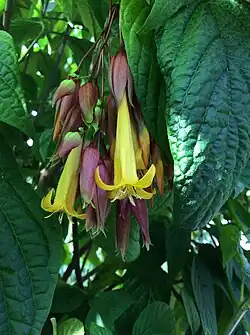Deppea splendens
| Golden fuchsia | |
|---|---|

| |
| Scientific classification | |
| Kingdom: | Plantae |
| Clade: | Tracheophytes |
| Clade: | Angiosperms |
| Clade: | Eudicots |
| Clade: | Asterids |
| Order: | Gentianales |
| Family: | Rubiaceae |
| Genus: | Deppea |
| Species: | D. splendens
|
| Binomial name | |
| Deppea splendens Breedlove & Lorence
| |
| Synonyms[2] | |
| |
Deppea splendens, also known as the golden fuchsia,[3][4] is a species of flowering plant in the family Rubiaceae endemic to Chiapas, Mexico.[2] It is extinct in the wild.[1][2]
Description
Deppea splendens is a 5–8 m (16–26 ft) tall shrub or tree with glabrous twigs.[5]
The terminal,[5] pendulous, brightly coloured inflorescences bear 16–25[5] pendulous, tubular,[4] ornithophilous[5] flowers with a red calyx and yellow-orange petals.[4]
Taxonomy
Dennis Breedlove was a botanist at the California Academy of Science researching plants and ethnobotany in Chiapas when he discovered it in 1972 in the Motozintla de Mendoza municipality; he brought seeds of the then undescribed shrub to San Francisco in 1981 (he described it formally in 1987). That seed was grown at the University of California Botanical Garden. All plants in existence are from that introduction. It is now grown widely grown, including in the San Francisco Conservatory of flowers, The San Francisco Botanical Garden at Strybing Arboretum, and at the Huntington in Southern California.[6]
Etymology
The specific epithet splendens means shining, brilliant,[7]
Distribution and habitat
It was once native to high elevation cloud forest in the state Chiapas, Mexico, but has been prusumed extinct in the wild since its habitat was cleared for farmland. It is now found only in horticulture, although efforts have been made to reintroduce it in Mexico.[6][1]
Conservation
The only known population was destroyed for farmland.[8][9] It only persists in ex-situ collections.[9]
Ecology
The flowers are pollinated by hummingbirds.[5][8]
Cultivation
It is cultivated in well-drained, nutrient rich substrate under bright and warm conditions.[8]
References
- ^ a b c Fuentes, A.C.D.; Martínez Salas, E.; Samain, M.-S. (2020). "Deppea splendens". IUCN Red List of Threatened Species. 2020: e.T126612397A126613386. doi:10.2305/IUCN.UK.2020-3.RLTS.T126612397A126613386.en.
- ^ a b c "Deppea splendens Breedlove & Lorence". Plants of the World Online. Royal Botanic Gardens, Kew. Retrieved 14 August 2025.
- ^ Holmes, B. "Deppea splendens Breedlove & Lorence (1987:43) | Golden fuschia". The Recently Extinct Plants and Animals Database. Retrieved 14 August 2025.
- ^ a b c "Golden Fuchsia (Deppea splendens)". Gardens by the Bay. Retrieved 14 August 2025.
- ^ a b c d e Borhidi, A.; Darók, J.; Kocsis, M.; Stranczinger, Sz.; Kaposvári, F. (2004). "Critical revision of the Deppea complex (Rubiaceae, Hamelieae)". Acta Botanica Hungarica. 46 (1–2): 77–89. doi:10.1556/ABot.46.2004.1-2.7.
- ^ a b Reynolds, Charles (2018). "Grow plants that are extinct in the wild". The Ledger.
- ^ Haynes, J. (2022). "Etymological Compendium of Cycad Names" (PDF). Phytotaxa. 550 (1): 1–31. Bibcode:2022Phytx.550....1H. doi:10.11646/phytotaxa.550.1.1.
- ^ a b c Bourell, M. "Deppea splendens". San Francisco Botanical Garden. Retrieved 14 August 2025.
- ^ a b "Deppea splendens". California Academy of Sciences. Retrieved 14 August 2025.
